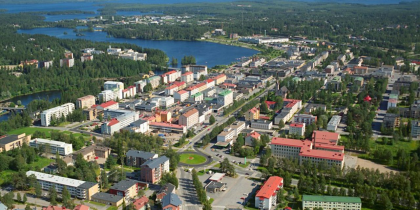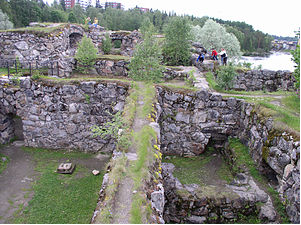Kajaani,Finland 作者: 来源: 发布时间:2021-02-19
一、所属省或是州,具体位置,人口,面积
Kajaani is a town and municipality in Finland. It is the center and capital of the Kainuu region. It is located southeast of Oulujärvi (Lake Oulu), which drains to the Gulf of Bothnia along the Oulujoki (river Oulu). As of 31 January 2019, it had a population of 36,943.

The town began in the 17th century, fuelled by the growth of the tar industry. It succumbed to Russian forces during the Greater Wrath of the 18th century, who ruined the Kajaani Castle in 1716. Today, the local economy is driven by mainly the sawmill, lumber and paper industries, although UPM Kymmene's Kajaani paper mill, the main employer from 1907 until 2008, has now closed. Kajaani Church was built in 1896 in the Neo-Gothic style by architect Jac Ahrenberg, replacing an earlier church. Kajaani Town Theatre was established in 1969. It is located in the province of Oulu and is the capital of the Kainuu region. It is located southeast of Oulujärvi (Lake Oulu), which drains to the Gulf of Bothnia along the Oulujoki (river Oulu).
Kajaani is home to two football clubs, AC Kajaani and Kajaanin Haka, and ice hockey team Hokki. Kajaani University of Applied Sciences was established in 1992.
As of 31 January 2019, the municipality has a population of 36,943 (around 34,000 in the town itself) and covers an area of 2,263.99 square kilometres (874.13 sq mi) of which 428.94 km2 (165.61 sq mi) is water. The population density is 20.13 inhabitants per square kilometre (52.1/sq mi).
The municipality is unilingually Finnish (only 0.09% of people from Kajaani speak Swedish as their first language).
二、自然地理
1.地理条件
Kajaani is situated in the heart of central Finland. By road is it 558 kilometres (347 mi) north-northwest of Helsinki, 170 kilometres (110 mi) north of Kuopio, and 182 kilometres (113 mi) southeast of Oulu. Villages in the vicinity include Jormua, Koutaniemi, Kuluntalahti, Lahnasjärvi, Lehtovaara, Linnantaus, Mainua, Murtomäki and Paltaniemi. Districts of Kajaani include: Heinisuo, Hetteenmäki, Hoikankangas, Huuhkajanvaara, Katiska, Kettu, Komiaho, Kuurna, Kylmä, Kättö, Kätönlahti, Laajankangas, Lehtikangas, Lohtaja, Nakertaja, Onnela, Palokangas, Petäisenniska, Puistola, Purola, Soidinsuo, Suvantola, Teppana, Tihisenniemi, Tikkapuro, Variskangas and Yläkaupunki.
Kajaani lies on the Kajaani River, between the lakes of Oulujärvi, which drains to the Gulf of Bothnia along the Oulu River, and Nuasjärvi. Between Kajaani and Oulujärvi are the smaller lakes of Sokajärvi and Paltajärvi, which are frozen during winter. Paltajärvi stands between the Kajaani River and Oulujärvi. The Kajaani and Vuolijoki rivers are noted for their fishing. Cuckoo Island (Käkisaari) lies on Oulu lake to the northwest of the town and features residential houses and about 150 summer cottages and holiday apartments, and Caterpillar Island (Toukka) lies in the eastern part of the lake. Also within the municipality is the 34.7 square kilometres (13.4 sq mi) Laakajärvi, a lake with a maximum depth of 25 metres (82 ft), which is a notable nesting area for Great black-backed gull and ospreys.
The surrounding area is dominated by mainly conifer forest, with broad-leafed birch and alder woods on some of the steeper banks and streams. An early 20th century analysis of vegetation cover in Kajaani county recorded 385 different species of vascular plants. Talaskangas Nature Reserve, with nearly pristine natural forest and about 50 different wildlife species, is in the Vieremä and Sonkajärvi local area. Logging was planned in the 1980s, but environmental activists prevented exploitation through lobbying. The reserve was formally established in 1994.
2. 交通情况
There is a daily bus service operating between Kajaani, Oulu, Kemijärvi and Rukatunturi, and Bus No.4 runs hourly during weekdays from Pohjolankatu in Kajaani to Paltaniemi. During the summer months there is a cruise service operating between Joensuu and Nurmes. Kajaani railway station opened in 1905 when the railway from Iisalmi to Kajaani was completed as an extension to the Savonia railroad. The station building was designed by Gustaf Nyström. The Kajaani station trackyard underwent significant upgrading and repair work in 2005, when the railway from Iisalmi to Kontiomäki was electrified. Four trains arrive daily from Helsinki via Kouvola and Kuopio, with the journey taking 7–10 hours to Helsinki depending on the train. There are also daily trains from Joensuu, and connecting trains between Nurmes and Kajaani.
Kajaani Airport
Kajaani Airport, approximately 7 kilometres (4 mi) northwest of Kajaani in the Paltaniemi area, is the main local airport. It is operated by Finavia, and also serves needs of non-commercial general aviation. Construction of the airport began in 1939 with the runway being completed in the autumn, but due to World War it was not fully opened until 22 June 1956. Aegean Airlines and Flybe Nordic provides flights to Chania and Helsinki. The Finnair connection to Helsinki operates during the summer twice daily and three times a day during the winter schedule period. In 2013 the airport served 74,558 passengers.
三、经济发展和规模
The budgeted income of Kajaani was FIM 930 million in 1996. In its earlier history, Kajaani was a thriving center of the tar industry. A channel built in 1846 especially for the transportation of tar out of the town still exists today.
The town’s role as the centre of excellence and concentration of innovations is prominent in the enterprise and industrial policy of Kajaani. We encourage and develop attraction and competitiveness factors and, in particular, the viability of local enterprises where also the public procurement of the City plays an important role.
In the early 1970s an electronics manufacturing plant was built in Kajaani, and the firm Kajaani Automation was established in 1980. As of 1999 the peat industry in Kajaani earned FIM 0.5 million annually. Some 222 hectares is allocated to peat production, with private firm Vapo Oy contracted to exploit it and deliver peat to the power plant.
According to 1999 figures, Kajaani earns FIM 3 million a year by selling forestry products, and also receives a sizable income from tourist-related activities from its forests. Fishing also contributes to the income of people in the town. Kajaani has three main hotels, the 191-room Scandic Kajanus Kajaani, Hotel Kajaani and Original Sokos Hotel Valjus, although the Karolineburg Manor House now also functions as a hotel with 20 rooms. The Sirius restaurant, cited as the best restaurant in the town, serves Finnish cuisine, and is housed in a former government building which hosted conferences between Leonid Brezhnev and Urho Kekkonen. Also of note is the Chinese restaurant Golden Dragon, the Torero which serves Spanish cuisine, Hospoda Kourna and Pikantti. The Central Hospital of Kainuu, which serves the wider region, is situated in Kajaani. Opened in 1968, it has a number of specialist medical departments and works in cooperation with the Oulu University Hospital. The town also has an eye clinic.
Kainuu Brigade, a unit of the Finnish Army established in 1966, is the third biggest employer in the city. The brigade trains around 4,000 conscripts each year and employs 500 military personnel and 100 civilians.
Regional GDP: 1,957 % of the National GDP: 1.09 Regional GERD (%): % of Unemployment: 12.7
四、产业特点重点项目
Today the local economy is driven by mainly the sawmill, lumber and paper industries. Kajaani paper mill, established in 1907 by Kajaani Oy (ex Kajaanin Puutavara Osakeyhtio), was the largest private employer in Kajaani. The factories are on the river bank, at Tihisenniemi. They built a new paper machine in the town in 1980 which was projected to have an annual output of 170,000 tons. Kajaani Oy was eventually acquired by Valmet in 1983, and the subsidiary Kajaani Electronics was formed. Kajaani Electronics was cited as "one of the leading makers of special sensors and analyzers for the pulp and paper industry" in 1990. When the paper mill was acquired by UPM Kymmene in 1989 it became the third-largest paper company in Finland. It closed in 2008 due to lack of profitability and high energy costs, but has since continued its operations, and was sold to Pölkky Oy in 2012.
五、风景名胜,景点( attractions)
1. Rokua National Park

Rokua National Park (Finnish: Rokuan kansallispuisto) is a UNESCO global geopark in the Northern Ostrobothnia region of Finland. The national park is located on the southern side of the Rokuanvaara Hill, where old pine forests grow in their natural state. The park lies within the municipalities of Vaala, Muhos and Utajärvi and in between the cities of Oulu and Kajaani.
2. Kajaani Castle Ruins

The Kajaani castle (Finnish: Kajaanin linna, Swedish: Kajaneborg, Kajaneborgs slott, or with older spelling Cajanaborg) was built on the Ämmäkoski island of the Kajaani river in the centre of Kajaani, Finland, in the 17th century. Today, only roofless ruins remain of the castle.
The castle functioned as an administrative centre, a prison, and a military strongpoint. The most famous prisoner in the castle was the historian Johannes Messenius, who was forced to live in the poor conditions of the castle from 1616 to 1635. Construction of the Kajaani castle began in 1604 and was completed in 1619. At first the castle only consisted of a stone wall, two round towers, and wooden buildings at the yard inside the castle.
3. Hiidenportti National Park

Hiidenportti National Park (Finnish: Hiidenportin kansallispuisto) is a national park in Sotkamo in the Kainuu region of Finland. Hiidenportti National Park was established in 1982 to preserve the region's wilderness. A mosaic mix of mires and dry forests is typical landscape in this national park. The park covers 45 square kilometres (17 sq mi).
Two thirds of the area is coniferous forest. The near-natural state forests are 100–150 years old on average. The last loggings were made in the beginning of the 20th century.
The most well-known attraction of the park is the Hiidenportti (literally "Hiisi´s gate") gulley with vertical cliffs.
六、历史文化
1.历史
Kajaani was one of the cities founded in 1651 by the Swedish Governor General of Finland, Per Brahe. At that time, the Kainuu region—as wood country—was an important producer of tar derived from pine, and the tar trade was its major industry.
2. 文化
The Kajaani Town Theatre, established in 1969 puts on plays and concerts, typically seen by around 200 people The Art Museum of Kajaani (Kajaanin taidemuseo), located in a building that was a police station, which is connected to Kajaani's former city hall was founded in 1993 and centers on Finnish modern art. Kainuu Museum (Kainuun Museo) displays information related to the tar industry, the Kalevala (the national epic of Finland) and author Elias Lönnrot and others on the ground floor, and regularly hosts temporary exhibitions upstairs.
The most notable annual cultural events in Kajaani are Kajaanin Runoviikko (The Kajaani Poetry Week) originally known as Sana ja Sävel, and Kainuun JazzKevät (The Kainuu Jazz Spring). Kajaani Orchestra began in the 1950s, and was expanded when the Kuopio garrison band moved to Kajaani in 1963.
Radio Kajaus, one of Finland's oldest local radios, began operations in Kajaani in 1989and remains one of the few completely independent radio stations in Finland. Kainuu Radio, which belongs to the Yle, broadcasts Monday to Friday from 6.30 to 17.00.
七、其他信息
Kajaani is a typical small and quiescent former industrial city. For most tourists, Kajaani is a stop on their way to Vuokatti skiing centre, which is located 40 kilometres east from the city. Because Kajaani still is the largest city (36 000 inhabitants) in Kainuu, there are more shopping opportunities than in Vuokatti. Especially Russian tourists who stay in Vuokatti are a common sight in the shops of Kajaani during the winter season.
八、联系方式
Mayor of Kajaani: Jari Tolonen
Address: Pohjolankatu 13, 87100 Kajaani
Phone number: +358 8 6155 2555
Email: kajaani.info@kajaani.fi
Website: www.kajaani.fi
Facebook: @visitkajaani
